10.8: Right Triangle Trigonometry
( \newcommand{\kernel}{\mathrm{null}\,}\)
- Apply the Pythagorean Theorem to find the missing sides of a right triangle.
- 2. Apply the
- Apply trigonometric ratios to find missing parts of a right triangle.
- Solve application problems involving trigonometric ratios.
This is another excerpt from Raphael’s The School of Athens. The man writing in the book represents Pythagoras, the namesake of one of the most widely used formulas in geometry, engineering, architecture, and many other fields, the Pythagorean Theorem. However, there is evidence that the theorem was known as early as 1900–1100 BC by the Babylonians. The Pythagorean Theorem is a formula used for finding the lengths of the sides of right triangles.
Born in Greece, Pythagoras lived from 569–500 BC. He initiated a cult-like group called the Pythagoreans, which was a secret society composed of mathematicians, philosophers, and musicians. Pythagoras believed that everything in the world could be explained through numbers. Besides the Pythagorean Theorem, Pythagoras and his followers are credited with the discovery of irrational numbers, the musical scale, the relationship between music and mathematics, and many other concepts that left an immeasurable influence on future mathematicians and scientists.
The focus of this section is on right triangles. We will look at how the Pythagorean Theorem is used to find the unknown sides of a right triangle, and we will also study the special triangles, those with set ratios between the lengths of sides. By ratios we mean the relationship of one side to another side. When you think about ratios, you should think about fractions. A fraction is a ratio, the ratio of the numerator to the denominator. Finally, we will preview trigonometry. We will learn about the basic trigonometric functions, sine, cosine and tangent, and how they are used to find not only unknown sides but unknown angles, as well, with little information.
Pythagorean Theorem
The Pythagorean Theorem is used to find unknown sides of right triangles. The theorem states that the sum of the squares of the two legs of a right triangle equals the square of the hypotenuse (the longest side of the right triangle).
The Pythagorean Theorem states
where
For example, given that side
Find the length of the missing side of the triangle (Figure ).
- Answer
-
Using the Pythagorean Theorem, we have
\[\begin{aligned}
(6)^2+b^2 & =(14)^2 \
36+b^2 & =196 \
b^2 & =196-36 \
b^2 & =160 \
b & = \pm \sqrt{160} \
& =4 \sqrt{10}=12.65
\end{aligned \nonumber \]When we take the square root of a number, the answer is usually both the positive and negative root. However, lengths cannot be negative, which is why we only consider the positive root.
Use the Pythagorean Theorem to find the missing side of the right triangle shown.
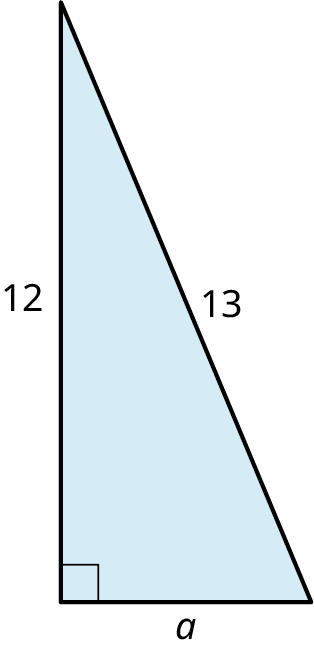
Distance
The applications of the Pythagorean Theorem are countless, but one especially useful application is that of distance. In fact, the distance formula stems directly from the theorem. It works like this:
In Figure
Thus,
You live on the corner of First Street and Maple Avenue, and work at Star Enterprises on Tenth Street and Elm Drive (Figure ). You want to calculate how far you walk to work every day and how it compares to the actual distance (as the crow flies). Each block measures 200 ft by 200 ft.
- Answer
-
You travel 7 blocks south and 9 blocks west. If each block measures 200 ft by 200 ft , then
As the crow flies, use the distance formula. We have
How far is it to your workplace (as the crow flies) if the blocks in the previous example measure 100 ft by 100 ft?
The city has specific building codes for wheelchair ramps. Every vertical rise of 1 in requires that the horizontal length be 12 inches. You are constructing a ramp at your business. The plan is to make the ramp 130 inches in horizontal length and the slanted distance will measure approximately 132.4 inches (Figure ). What should the vertical height be?
- Answer
-
The Pythagorean Theorem states that the horizontal length of the base of the ramp, side a, is 130 in. The length of c, or the length of the hypotenuse, is
The Pythagorean Theorem states that the horizontal length of the base of the ramp, side
Then, by the Pythagorean Theorem, we have:
If you construct the ramp with a 25 in vertical rise, will it fulfill the building code? If not, what will have to change?
The building code states 12 in of horizontal length for each 1 in of vertical rise. The vertical rise is 25 in, which means that the horizontal length has to be
The new ramp will look like Figure 10.185.
Figure
If 10 in is the maximum possible vertical rise as shown in the figure, how long would the ramp have to be to pass the building code rule of 12 horizontal inches to 1 vertical inch?

In geometry, as in all fields of mathematics, there are always special rules for special circumstances. An example is the perfect square rule in algebra. When expanding an expression like
If we know the perfect square formula, given as
we can skip the middle step and just start writing down the answer. This may seem trivial with problems like
We see that the shortest side is opposite the smallest angle, and the longest side, the hypotenuse, will always be opposite the right angle. There is a set ratio of one side to another side for the
Find the measures of the missing lengths of the triangle (Figure ).
- Answer
-
We can see that this is a
Side
Find the lengths of the missing sides in the given figure.
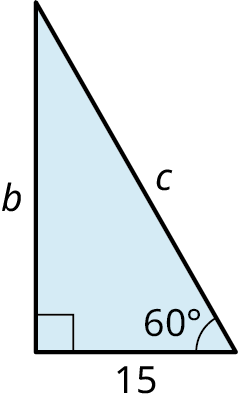
A city worker leans a 40-foot ladder up against a building at a
- Answer
-
We have a
You want to repair a window on the second floor of your home. If you place the ladder at a
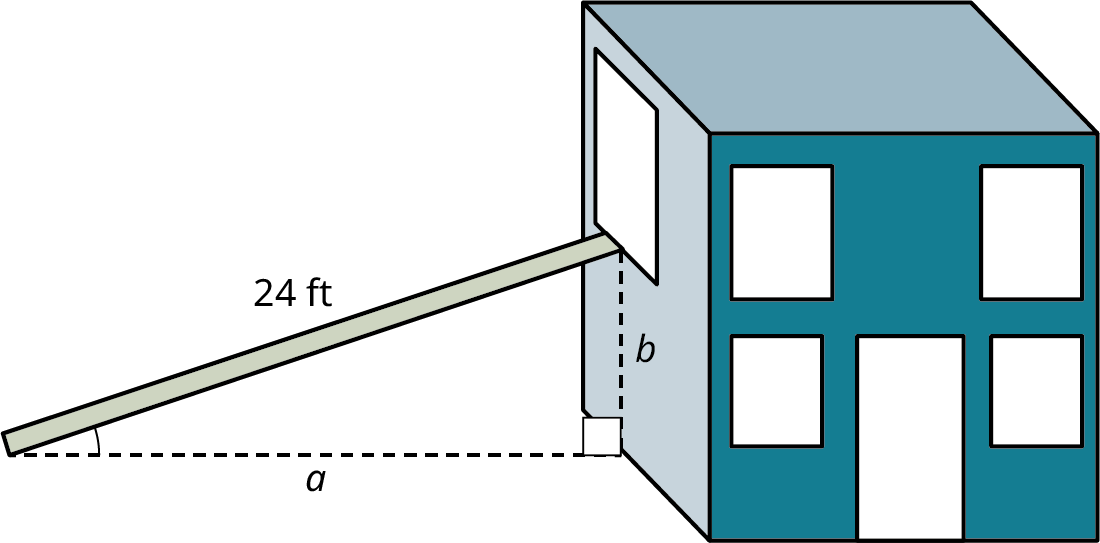
The
Find the measures of the unknown sides in the triangle (Figure 10.193).
- Answer
-
Because we have a
Find the measures of the unknown sides in the given figure.

Trigonometry Functions
Trigonometry developed around 200 BC from a need to determine distances and to calculate the measures of angles in the fields of astronomy and surveying. Trigonometry is about the relationships (or ratios) of angle measurements to side lengths in primarily right triangles. However, trigonometry is useful in calculating missing side lengths and angles in other triangles and many applications.
NOTE: You will need either a scientific calculator or a graphing calculator for this section. It must have the capability to calculate trigonometric functions and express angles in degrees.
Trigonometry is based on three functions. We title these functions using the following abbreviations:
-
-
-
Letting
Table Trigonometric Ratios
We will be applying the sine function, cosine function, and tangent function to find side lengths and angle measurements for triangles we cannot solve using any of the techniques we have studied to this point. In Figure , we have an illustration mainly to identify
An angle
Let’s use the trigonometric functions to find the sides
We have
Next, let's find
Now we have all sides,
Find the lengths of the missing sides for the triangle (Figure ).
- Answer
-
We have a
Step 1: To find the length of
Step 2: We can use the Pythagorean Theorem to find the length of
Step 3: Now that we have
Find the lengths of the missing sides in the given figure.
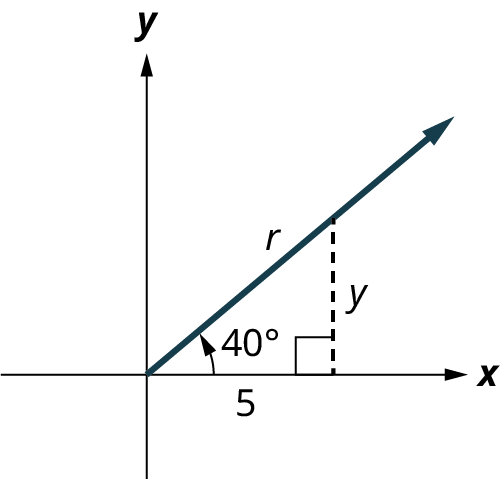
To find angle measurements when we have two side measurements, we use the inverse trigonometric functions symbolized as
You can also use the inverse sine function and enter the values of
Finally, we can also use the inverse tangent function. Recall
Solve for the lengths of a right triangle in which
- Answer
-
Step 1: To find side
Step 2: To find
Step 3: Since this is a
Find the missing side and angles in the figure shown.
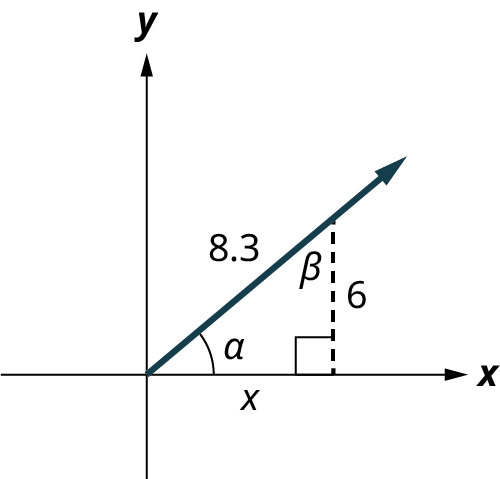
A small plane takes off from an airport at an angle of
- Answer
-
To solve this problem, we use the tangent function:
The plane's altitude when passing over the peak is
Suppose that the plane takes off at a
Suppose you have two known sides, but do not know the measure of any angles except for the right angle (Figure )). Find the measure of the unknown angles and the third side.
- Answer
-
Step 1: We can find the third side using the Pythagorean Theorem:
Now, we have all three sides.
Step 2: To find
The angle
Step 3: To find
Step 4: To find the last angle, we just subtract:
You know the lengths of two sides and the right angle as shown in the figure. Find the length of the third side and the other angles.
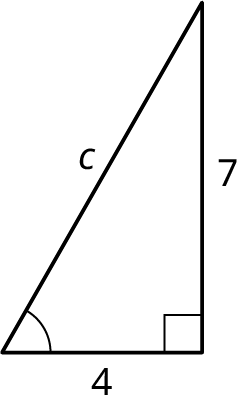
Angle of Elevation and Angle of Depression
Other problems that involve trigonometric functions include calculating the angle of elevation and the angle of depression. These are very common applications in everyday life. The angle of elevation is the angle formed by a horizontal line and the line of sight from an observer to some object at a higher level. The angle of depression is the angle formed by a horizontal line and the line of sight from an observer to an object at a lower level.
A guy wire of length 110 meters runs from the top of an antenna to the ground (Figure ). If the angle of elevation of an observer to the top of the antenna is
- Answer
-
We are looking for the height of the tower. This corresponds to the
The tower is 75 m high.
You travel to Chicago and visit the observation deck at Willis Tower, 1,450 ft above ground. You can see the Magnificent Mile to the northeast 6,864 ft away. What is the angle of depression from the observation deck to the Magnificent Mile?
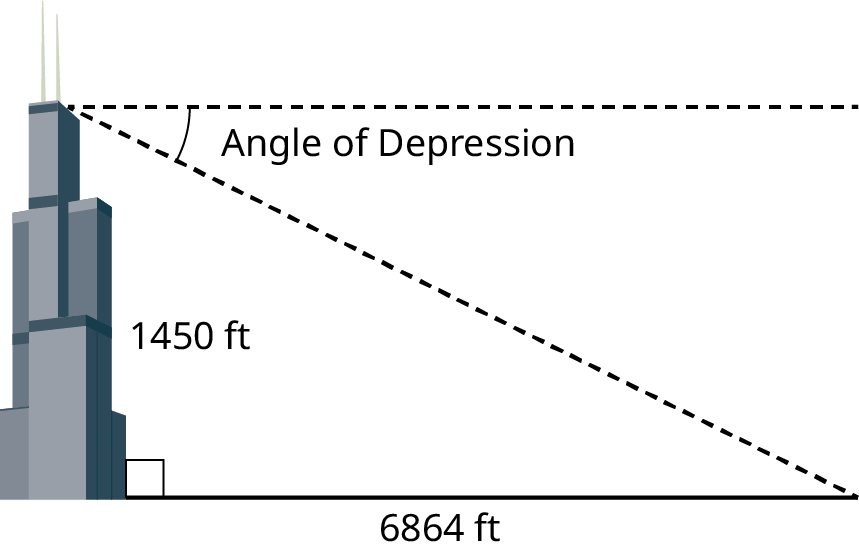
You are sitting on the grass flying a kite on a 50-foot string (Figure )). The angle of elevation is
- Answer
-
We can solve this using the sine function,
You are flying a kite on a 60-foot string. The angle of elevation from the ground to the kite is
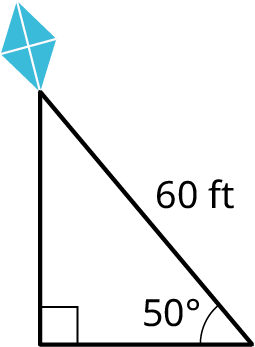
The Pythagorean Theorem is so widely used that most people assume that Pythagoras (570–490 BC) discovered it. The philosopher and mathematician uncovered evidence of the right triangle concepts in the teachings of the Babylonians dating around 1900 BC. However, it was Pythagoras who found countless applications of the theorem leading to advances in geometry, architecture, astronomy, and engineering.
Among his accolades, Pythagoras founded a school for the study of mathematics and music. Students were called the Pythagoreans, and the school’s teachings could be classified as a religious indoctrination just as much as an academic experience. Pythagoras believed that spirituality and science coexist, that the intellectual mind is superior to the senses, and that intuition should be honored over observation.
Pythagoras was convinced that the universe could be defined by numbers, and that the natural world was based on mathematics. His primary belief was All is Number. He even attributed certain qualities to certain numbers, such as the number 8 represented justice and the number 7 represented wisdom. There was a quasi-mythology that surrounded Pythagoras. His followers thought that he was more of a spiritual being, a sort of mystic that was all-knowing and could travel through time and space. Some believed that Pythagoras had mystical powers, although these beliefs were never substantiated.
Pythagoras and his followers contributed more ideas to the field of mathematics, music, and astronomy besides the Pythagorean Theorem. The Pythagoreans are credited with the discovery of irrational numbers and of proving that the morning star was the planet Venus and not a star at all. They are also credited with the discovery of the musical scale and that different strings made different sounds based on their length. Some other concepts attributed to the Pythagoreans include the properties relating to triangles other than the right triangle, one of which is that the sum of the interior angles of a triangle equals
In Figure 10.208, which is one of the more popular visualizations of the Pythagorean Theorem, we see that square
Thus, the sum of the squares of the two legs of a right triangle is equal to the square of the hypotenuse, as stated in the Pythagorean Theorem.
Check Your Understanding
1. Find the lengths of the unknown sides of the
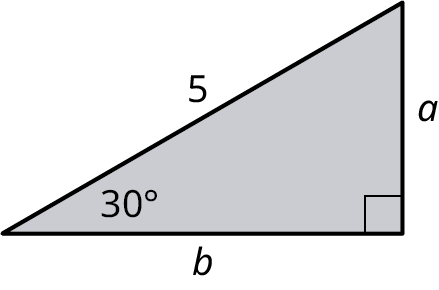
2. Find the missing lengths of the

3. Use the Pythagorean theorem to find the missing length in the triangle shown.

4. The sun casts a shadow over the roof of a house that ends 105 ft from the front door as shown in the figure. How high is the house to the tip of the roof?

5. Find the measure of side

6. Find the measure of side



